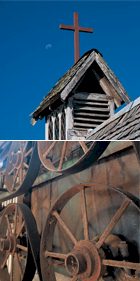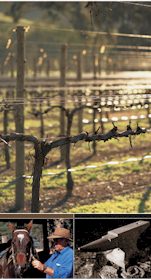


Inflicted with cruel and regular droughts, these men and women faced the option of giving up and starving along with their cattle and sheep or flinging open their boundary gates and allowing their stumbling, starving stock to roam the bush roads and tracks in the desperate hope of finding food and water. Somewhere. Anywhere. This was known as “droving the Long Paddock”, a task that could take them away from their family and home for months and months. Sometimes even years. Fortunately some stock was saved. Unfortunately for some, when the rains didn’t come the heartbreak of seeing their stock die became a regular occurrence. This was the beginning of the Long Paddock tradition.

Long Paddock's flagship Anvil Shiraz reminds us of times gone by when settlers handcrafted their farming implements with the heat of the forge and the strength of the anvil. Filled with hope and determination, these pioneers set about taming much of Victoria’s uncharted lands. Celebrating the badge of Redbank, The Anvil Shiraz continues the Redbank philosophy of seeking outstanding fruit from premium regions within Victoria.
Much of Victoria is littered with long abandoned miners' camps and long forgotten mine shafts that gave little to the battling prospector of the 1850s gold rush. During the same time notorious bushrangers roamed the high country of North East Victoria robbing the gold and mail coaches and stealing the valuable livestock of wealthy land owners. This colouful heritage inspired the wines from the King Valley. New varietal styles from high altitude vineyards reflect the diversity of the King Valley. Fruit for these wines is harvested from vineyards that sit at nearly 800 metres above sea level, covered in snow in winter and shrouded in cloud during other times of the year.
The high altitude valleys of Eastern Victoria are about three hours drive from the state capital, Melbourne. Situated in the heart of the Alpine Way, the region was the home of The Man from Snowy River, the horseman immortalised in Banjo Patterson's classic Australian poem. After the Second World War, the region was settled by many Europeans, mainly Italian. These hard-working migrants established a thriving farming community. The rich, fertile soils and high rainfall provided an ideal climate for growing quality crops. The most prolific plantings were tobacco, but other crops such as hops and wine grapes also grew well.

Today tobacco and hops farming has all but disappeared, and the region is becoming one of the more important cool climate grape growing areas in Australia. More than 2,500 acres are planted out to premium grape varieties, with some vineyards planted in granite based soils on mountain slopes more than 800 metres above sea level. Early autumn mornings see these vineyards hidden by low cloud that shrouds the nearby mountains.
The Long Paddock winemakers and viticulturists work closely with a dedicated family of carefully selected independent growers. These small family-run vineyards offer unique and subtle soil and altitude differences that provide the winemakers with an opportunity to create distinctive wines reflecting the finest attributes of the regions. Fruit for the Long Paddock and King Valley wines is sourced from high-altitude vineyards in Victoria’s high country, from the Alpine, King and Ovens Valleys.
The magnificent fifteen hectare Myrrhee Ridge vineyard has been added to the Redbank portfolio. This uniquely located vineyard in the mountain range which overlooks the township of Whitfield in the King Valley has supplied Shiraz grapes for Redbank wines since it was established ten years ago. In the Spring of 2006 plantings of Pinot Gris and Garganega vines were added.
Long Paddock's flagship Anvil Shiraz is crafted from fruit from the Heathcote region of Central Victoria.Unlike the high altitude vineyards of the King and Ovens Valleys in Victoria's high country, Heathcote is a long-established wine growing area in Central Victoria, approximately two hours North West of Melbourne. The first vines were planted in the 1860s. Sadly the vines were virtually wiped out by phylloxera in 1893, and it wasn't until the 1960s that the region was re-established. Today there are approximately 2900 acres under vines.
